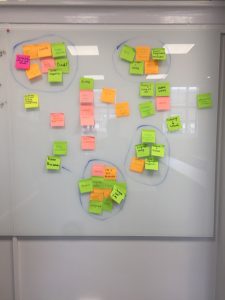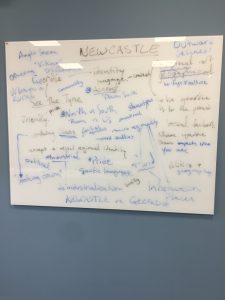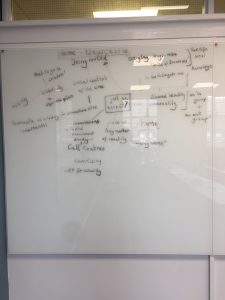
Here are the image hand-outs I distributed in class; the first, a collection of stereotypical references and iconography of Newcastle reinforced in popular culture.
Images taken from:
A Touch Far Vetched fan Blog – NUFC image
The Chronicle Live (local newspaper)
Amber Films website (local film studio)
The second, a collection of photos I took during research fieldwork in 2011, representing something of the reality of Newcastle (at that time)
What I was hoping to illustrate here, were how representations in popular media about Newcastle, construct and rely on stereotypes and caricatures (eg. the old steep cobbled streets of Byker, the landmark Tyne Bridge. There’s a familiarity about these images, which is part of the reason we except them and continue to refer to them as ‘standing for’ Newcastle.
The selection of photographs I took during fieldwork, observing, making notes and walking around Newcastle, shows some similarities to the first hand-out, so Cruddus Park housing block for example, communal living at least, not being dissimilar from the image of bygone Byker. However, the Polish café sign, and the ‘To let’ board in Chinese Mandarin, speak of a more culturally diverse Newcastle than the one being persistently portrayed in popular culture.
If you’re interested in this relationship between Popular Culture, Representation and the City take a look at the work of Grieves (1985). While some of the cultural references in this thesis are outdated, the theoretical framework of the piece is still very relevant.
Grieves, James (1985) Popular culture and public order: an empirical investigation into socio-cultural relationships in the city of Newcastle upon Tyne. Doctoral thesis, Durham University.
To finish then, take a look at the opening theme tune of popular BBC children’s drama from the 1980s, Geordie Racer (BBC Look and Read series, BBC Two, 1988, dir. David Meldrum). The city of Newcastle Upon Tyne was an integral feature of the show, a show which was incidentally praised as presenting a ‘grittier’ image of everyday family like to children’s television programming. What might this say about Newcastle’s (mis)place (ment) in popular culture? The iconic and rousing images of The Great North Run moving across the Tyne Bridge, against the traditional working class pastime of pigeon racing…
And finally, to link in with our thoughts on the song ‘Home Newcastle’ https://blogs.ncl.ac.uk/chnewcastleblog/2017/07/04/home-Newcastle , here are the lyrics to the theme tune of Geordie Racer, written by Derek Griffiths:
Flying free, flying high,
Flashing wings across the sky,
Geordie racer, Geordie racer.
On the road, in the street,
Hear the sound of pounding feet,
Geordie racer, Geordie racer.
Don’t wait, don’t stop,
You’re heading home.
Don’t rest, don’t drop,
You’re heading home.
In the air, on the ground,
See them moving all around.
Running hard, flying fast,
See them all go rushing past,
Geordie racer – fly!





